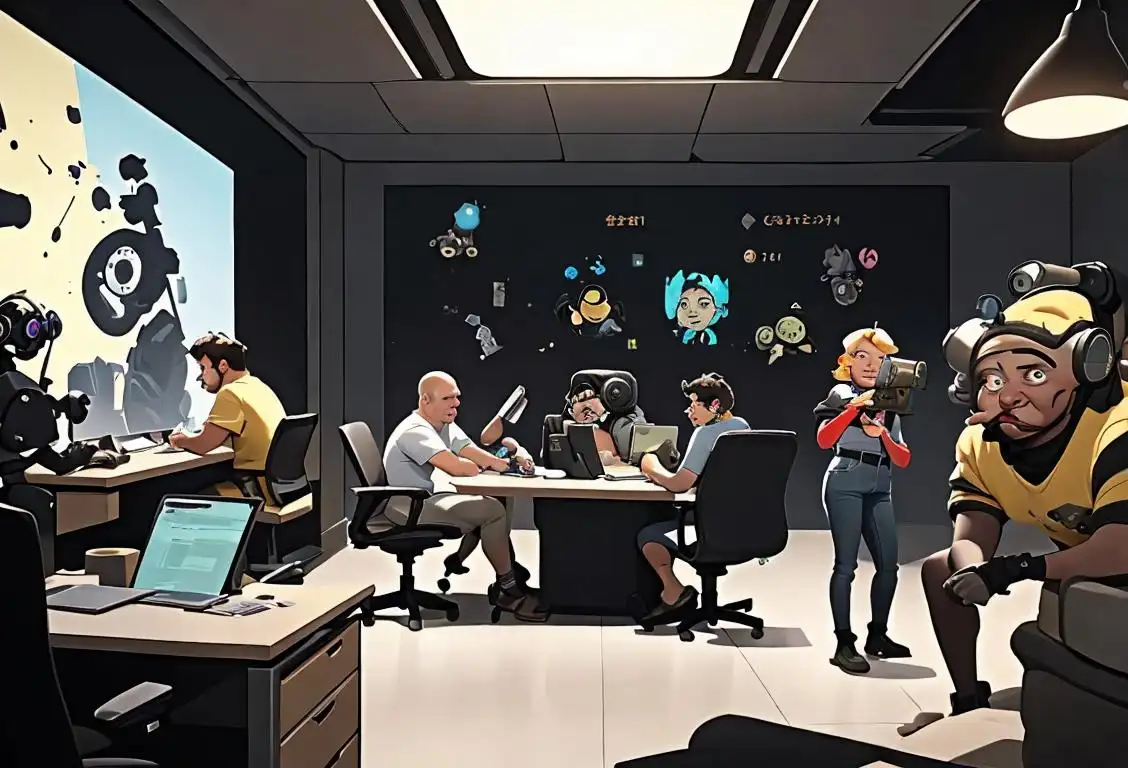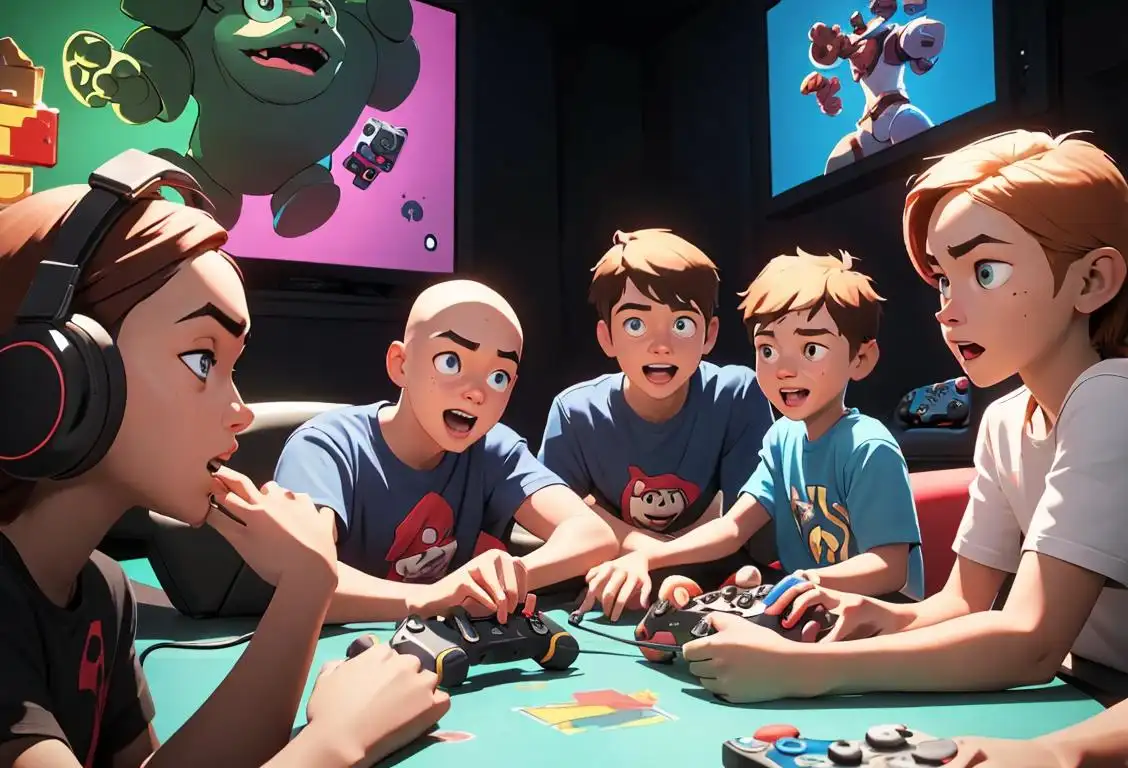National Videogames Day

Hey there, gamers! Get ready to power up and press start because it's National Videogames Day! 🎮🎉
When is Videogames Day?
It's national videogames day on the 12th September.
The Birth of Gaming Obsession
Let's dive into the exciting world of National Videogames Day, where pixels and controllers reign supreme. This extraordinary day celebrates the joy, the frustration, and the addictive nature of video games that have captivated players for years.
Leveling Up: The Internet's Influence
As video games evolved, so did the internet, and the two are now inseparable. Gamers from around the globe connect with each other in massive online communities to discuss strategies, share game tips, and forge new friendships.
Gone are the days of solitary gaming sessions. Now, you can battle against opponents from halfway across the world or team up with friends to conquer virtual realms. The internet has turned gaming into a truly social experience, allowing you to connect with fellow gamers and form virtual bonds.
Reaching New High Scores
On September 12th, 2018, the internet exploded with excitement for National Videogames Day. With 265 mentions online, it was clear that gamers worldwide were eager to spread the love for their favorite pastime.
The Perfect Way to Celebrate
So, how can you make the most of National Videogames Day? Gather your friends, grab some snacks, and dive into a gaming marathon. Dust off that old console you stored away and rediscover the classics or dive into the latest and greatest releases. Whether you're a fan of action-packed adventures, brain-bending puzzles, or epic multiplayer battles, there's a game out there just waiting to be conquered.
If you're feeling competitive, challenge your friends to a gaming tournament. Who will come out on top and claim the title of the ultimate gamer? Or, if you're feeling less competitive and more nostalgic, why not revisit the games that defined your childhood?
Did You Know?
The oldest known video game competition on record took place in 1972. Students at Stanford University competed in a game of Spacewar!, with the winner earning a one-year subscription to Rolling Stone magazine. Talk about sweet rewards!
History behind the term 'Videogames'
1950
Birth of Computer Games
The origins of video games can be traced back to the early 1950s when scientists and researchers started experimenting with computer-based games. In 1950, British computer scientist Christopher Strachey developed a draughts (checkers) program for the Ferranti Mark I computer. Strachey's program is considered to be one of the earliest examples of a video game.
1947
The Birth of the Cathode Ray Tube Amusement Device
In 1947, Thomas T. Goldsmith Jr. and Estle Ray Mann filed a patent for the Cathode Ray Tube Amusement Device, which is considered the first video game-like invention. This device used a cathode-ray tube display to generate simple graphical targets that players could shoot using a light gun. Although it was only a mechanical simulation, it laid the groundwork for later electronic video games.
1950
Early Concept: Cathode Ray Tube Amusement Device
The concept of videogames can be traced back to 1950 when the 'Cathode Ray Tube Amusement Device' was developed by Thomas T. Goldsmith Jr. and Estle Ray Mann. The device used cathode ray tubes to display simple geometric shapes on a screen, which the players would shoot at using a rifle for entertainment purposes. Though this device was never mass-produced or commercially available, it laid the foundation for future developments in the field of interactive entertainment.
1958
Creation of Tennis for Two
In 1958, William Higinbotham, a physicist at the Brookhaven National Laboratory, created 'Tennis for Two.' It was a simple tennis simulation displayed on an oscilloscope. This game allowed two players to compete against each other, and it is often considered one of the first video games to be played on an electronic display.
1958
Tennis for Two: The First Video Game on a Screen
In 1958, the physicist William Higinbotham created what is widely recognized as the first video game displayed on a screen. Dubbed 'Tennis for Two,' this game was played on an oscilloscope and simulated a game of tennis. While it was only a two-player game, Tennis for Two showcased the potential of electronic technology to create interactive entertainment.
1962
Spacewar! Brings Interactive Gaming to Computers
In 1962, 'Spacewar!', a computer game developed by Steve Russell, became the first widely recognized example of a video game. Programmed on the Digital Equipment Corporation's PDP-1 mainframe computer at the Massachusetts Institute of Technology (MIT), 'Spacewar!' allowed two players to engage in a space combat simulation using joystick controllers. The game's success and popularity helped pave the way for the future development of video games as a form of entertainment.
1962
Introduction of Spacewar!
The year 1962 saw the introduction of one of the most influential video games in history, 'Spacewar!'. Created by a group of computer scientists at MIT, Spacewar! was a space combat game played on PDP-1 minicomputers. It showcased the potential for interactive entertainment on computers and laid the foundation for future video game development.
1962
SpaceWar!: The Emergence of Multiplayer Gaming
In 1962, the game 'SpaceWar!' was developed by Steve Russell and a team of fellow students at the Massachusetts Institute of Technology (MIT). It was the first video game to be played on multiple computer systems, allowing two players to engage in a space combat simulation. 'SpaceWar!' laid the foundation for multiplayer gaming and inspired future video game developers.
1972
Magnavox Odyssey: The First Home Video Game Console
In 1972, the Magnavox Odyssey was released, marking the birth of home video game consoles. Developed by Ralph Baer, the Odyssey allowed players to interact with simple games such as Pong, Hockey, and Table Tennis using dedicated controllers. Although the Odyssey had limited graphics and sound capabilities, it sparked widespread interest in video gaming and laid the groundwork for the home console industry.
1972
The Rise of Arcade Games
The advent of arcade games in 1972 marked a significant milestone in the history of video games. Nolan Bushnell and Ted Dabney founded Atari, Inc., and released 'Pong,' a simple table tennis game. Pong quickly became a sensation, sparking the popularity of arcade gaming and setting the stage for the video game industry's rapid growth.
1978
Atari 2600 Revolutionizes Home Gaming
The year 1978 was a significant milestone in the history of video games with the release of the Atari 2600, or Atari VCS (Video Computer System). Developed by Atari, the 2600 was the first console to utilize interchangeable cartridges, allowing players to have access to a wide variety of games. The Atari 2600 rapidly gained popularity, contributing to the widespread adoption and commercial success of home video game consoles.
1972
Atari Pioneers the Home Video Game Console
In 1972, Atari released Pong, a coin-operated game that became wildly popular and kickstarted the home video game console revolution. Pong was a simple tennis-themed game, but its success prompted Atari to develop a home version. The release of the Atari Home Pong console in 1975 marked the beginning of video gaming as a mainstream form of entertainment.
1983
The Video Game Crash and the Rise of Nintendo
In 1983, the video game industry suffered a severe downturn known as the Video Game Crash. This crash was caused by a flood of poor-quality games and multiple home video game consoles saturating the market. However, Nintendo's release of the Nintendo Entertainment System (NES) in 1985 brought the industry back to life through successful titles like Super Mario Bros. and The Legend of Zelda.
1977
Release of the Atari 2600
In 1977, Atari released the Atari 2600, a home video game console that revolutionized the gaming industry. With interchangeable game cartridges and a wide range of titles available, the Atari 2600 brought video games into the living rooms of millions of people. It became the best-selling console of its time and solidified video games as a cultural phenomenon.
1985
Super Mario Bros.: A Gaming Icon
In 1985, Nintendo released 'Super Mario Bros.', a game that would become an industry icon and one of the most bestselling video games of all time. Created by Shigeru Miyamoto, 'Super Mario Bros.' introduced side-scrolling platform gameplay, vibrant graphics, and memorable characters, elevating video games into a mainstream form of entertainment. Its success helped solidify Nintendo's dominance in the home console market.
1985
The Birth of Super Mario
In 1985, Nintendo introduced 'Super Mario Bros.,' a groundbreaking platformer that propelled the popularity of video games to new heights. Developed by Shigeru Miyamoto, Super Mario Bros. captured players' imaginations with its engaging gameplay, memorable characters, and innovative level design. The game became a cultural icon and solidified Nintendo's position as a dominant force in the video game industry.
1994
PlayStation: The Rise of CD-based Consoles
1994 marked a significant shift in the gaming industry with the release of Sony's PlayStation console. Unlike its cartridge-based predecessors, the PlayStation utilized CD-ROMs, allowing developers to create games with expansive worlds, full-motion videos, and more immersive experiences. The PlayStation's success not only established Sony as a major player in the console market but also paved the way for future CD-based consoles like the PlayStation 2 and Xbox.
1990
Sega Genesis vs. Super Nintendo: Console Wars Begin
The early 1990s marked the beginning of the fierce competition between Sega and Nintendo known as the 'Console Wars.' Sega released the Genesis console in 1989, offering advanced graphics and a more mature gaming experience. Nintendo responded with the Super Nintendo Entertainment System (SNES) in 1991, initiating a heated rivalry that defined the gaming landscape of the decade.
1996
Sony PlayStation: The Era of CD-Based Gaming
In 1996, Sony introduced the PlayStation console, which revolutionized the gaming industry by utilizing CD-ROM technology. The PlayStation's ability to store vast amounts of data on CDs allowed for more immersive and complex game experiences. It became a major success and set the stage for future generations of CD and DVD-based consoles.
2007
iPhone and Mobile Gaming Revolution
With the introduction of the iPhone in 2007, mobile gaming experienced a revolution. The App Store provided a platform for developers to create and distribute games directly to mobile devices, reaching a massive audience. Mobile games became increasingly sophisticated, offering console-like experiences on smartphones and tablets. The accessibility and convenience of mobile gaming contributed to its explosive growth, making it a dominant force in the video game industry.
1994
The Emergence of 3D Gaming
The year 1994 marked a significant leap forward in video game technology with the release of three-dimensional (3D) games. The emergence of consoles like the Sony PlayStation and the Sega Saturn brought immersive gaming experiences to a broader audience. Games like 'Super Mario 64' and 'Tomb Raider' showcased the exciting possibilities of 3D graphics and gameplay mechanics.
2006
The Advent of Modern Console Generations
In 2006, Sony released the PlayStation 3, Microsoft introduced the Xbox 360, and Nintendo unveiled the Wii. This marked the beginning of the seventh generation of video game consoles. These consoles pushed the boundaries of graphics, introduced motion controls, and offered online multiplayer experiences, transforming the way people play and interact with video games.
2016
The Rise of Mobile Gaming
With the widespread adoption of smartphones, mobile gaming emerged as a dominant force in the gaming industry. The simplicity and accessibility of games like 'Angry Birds' and 'Candy Crush Saga' attracted millions of casual gamers worldwide. Mobile gaming continues to grow rapidly, with an increasing emphasis on quality, immersive experiences that rival traditional console and PC games.
Did you know?
The oldest known video game competition on record took place in 1972. Students at Stanford University competed in a game of Spacewar!, with the winner earning a one-year subscription to Rolling Stone magazine. Talk about sweet rewards!Tagged
fun technology gamingFirst identified
12th September 2015Most mentioned on
12th September 2018Total mentions
265Other days
Video Game Video Game Day
Videogames Day
Digital Day
Techies Day
Stockpile Website A Day
Battery Day
It Professionals Day
Radio Day
Stem Day
Video Games Day








